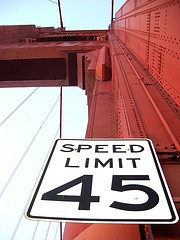 The duty of speed requires that all drivers drive the speed limit or the speed which is reasonable for the conditions—whichever is less. The speed limit is either the posted speed or depends on the classification of the roadway and/or neighborhood. Clearly, you should not be driving at freeway speeds when driving in a residential neighborhood. Also, if changes in the weather create conditions of snow, ice, rain, or fog, then you should act as a reasonable person would. Therefore, the law requires that you adjust your speed in accordance with the environment and safety considerations. These safety considerations involve the so-called “trinity” of elements: “lookout,” “speed,” and “control.” Oregon law and courts takes all three of these elements into consideration. In this section on “speed,” we will concentrate on looking at just the issue of “speed.”
The duty of speed requires that all drivers drive the speed limit or the speed which is reasonable for the conditions—whichever is less. The speed limit is either the posted speed or depends on the classification of the roadway and/or neighborhood. Clearly, you should not be driving at freeway speeds when driving in a residential neighborhood. Also, if changes in the weather create conditions of snow, ice, rain, or fog, then you should act as a reasonable person would. Therefore, the law requires that you adjust your speed in accordance with the environment and safety considerations. These safety considerations involve the so-called “trinity” of elements: “lookout,” “speed,” and “control.” Oregon law and courts takes all three of these elements into consideration. In this section on “speed,” we will concentrate on looking at just the issue of “speed.”
Speed and Other Factors
Whether your speed is reasonable depends upon the relationship of speed with a number of other factors. For example, you may need to reduce your speed in order to clearly see what is ahead. This is what the law and courts define as your “duty of care.” That means you may have to reduce your speed in order to maintain a “proper lookout.”
Also, your speed might have to be adjusted due to changes in the weather—so that you can take into account hazardous conditions. In such a situation, the element of “control” factors into the safe driving equation. That is because every driver has a duty to maintain reasonable degree of control over his-her vehicle. So, if the speed is over the limit—or is not reasonable for the conditions—then the speed is excessive, creates dangerous conditions, and violates the duty of care.
Example-Illustration
A good example which ties together the relationship of speed with lookout and control is the rear-end collision. In a rear-end collision case, the most common failure is lookout. In other words, the offending driver was not looking where he-she was going because they were looking away from the road. A bit less common is the stop in traffic, in which case it is a combination of: (1) speed, (2) lookout, and (3) control. This situation may involve the statutory offense of following too closely. In the non-intentional car collision cases, liability will boil down to question about what we call the “trinity” of elements: (1) speed, (2) lookout and, (3) control. It is a very rare case which is a true “accident”—where none of the drivers are at fault.
General Rule
The general rule of the common law forbids creating an unreasonable risk of harm—which is Oregon’s formulation of negligence law. In most auto collision cases, the elements of negligence include evaluating all three factors of the “trinity”—speed, lookout, and control.
To Look and Not See
If a driver looks but fails to see something that is plainly visible, then the Oregon rule is that the driver is still liable in negligence. It is for that reason that a court will still submit all three elements of the “trinity” to a jury when it considers liability for negligence. “Lookout” by its very definition is the one of three elements which is the least subject to proof from direct evidence. Almost always, the extent of lookout must be inferred from other facts—which includes speed. This is where the adequacy of driver’s degree of lookout must be determined in relation to “speed” and “control.” Hence, we are returned to the need for a jury to look at the “trinity” of “speed,” “control,” and “lookout” when considering the questions surrounding a driver’s duty and possible negligence in an auto accident.

